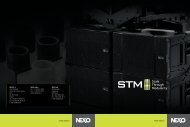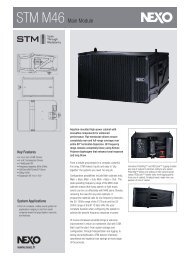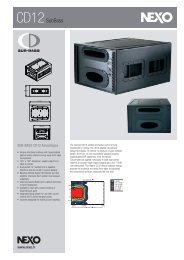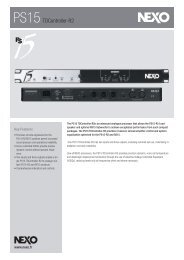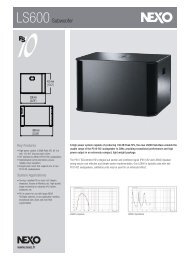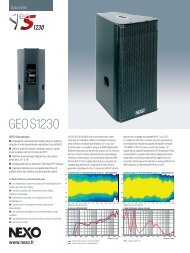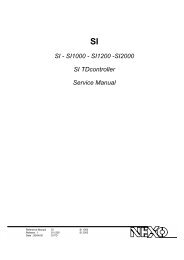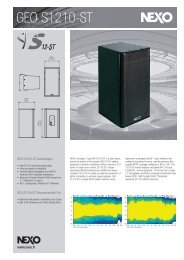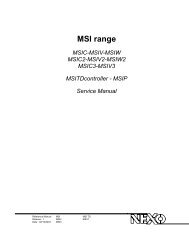NXAMP4x1 & NXAMP4x4 User Manual - Nexo
NXAMP4x1 & NXAMP4x4 User Manual - Nexo
NXAMP4x1 & NXAMP4x4 User Manual - Nexo
- No tags were found...
You also want an ePaper? Increase the reach of your titles
YUMPU automatically turns print PDFs into web optimized ePapers that Google loves.
BLOCK DIAGRAM DESCRIPTIONThe so-called Physiologic Dynamic Control (see block diagram) is intended to avoidunwanted effects as a result of a too long attack time constant. By anticipating theoperation of the temperature limiter, it prevents a high level Audio signal appearingsuddenly then being kept up for a period, which is long enough to trigger the temperaturelimiter. Without this, a rough and delayed gain variation would result which would be quitenoticeable and unnatural.The Physio control voltage acts independently on the VCA with its operation thresholdslightly lower (3 dB) that of the temperature limiter and a low compression ratio; itsoptimised attack time constant allows it to start operating without any subjectivelyunpleasant transient effects.Interchannel regulation (19)As described before, each transducer is individually servo-controlled for temperature. Thismeans in practice that, in case of a potential risk detected, protective operation would onlyaffect the concerned driver. Your driver will be protected but the overall system tonalbalance could be altered if the different channels are not heating at the same time. Inaddition, triggering a temperature protection means that the loudspeaker has already lostsome efficiency (power compression up to 3dB in extreme cases)The purpose of interchannel regulation is to cancel that effect by linking VCAs together.When the protection is activated on one channel and reaches a predetermined threshold,the regulation section begins to correct the balance between the different channels (HF,MF, and LF) by acting on the concerned VCA.Amplifier peak current limiter (20)To prevent over-current on the output of the amplifier, this peak current limiter isimplemented, leading to a separate VCA (block (30)) from the one being used forloudspeaker protection (block (26)). This protection is implemented here mostly in case ofdefault of the power supply, and will barely be triggered during normal use, because it isset up at the limit of what can deliver the power supply of the amplifier.Amplifier integrate current limiter (21)This protection which is also triggering a VCA will compute the integration of the currentover time to check that the current drawn by the amplifier will not go above what isacceptable for the mains. With musical signal should never trigger this protection, mainlyimplemented for protection against continuous signal like sine wave and so on.Amplifier peak voltage limiter (22)This is a “soft clip” limiter that will reduce the output level though a VCA process to limitthe clipping of the amplifier.Amplifier short circuit detector (24)If a short circuit is detected on the output, the amplifier will mute itself, and will release themute a few second after automatically. This is shown on the front panel by a blinking of thepeak LED of the concerned channel, together with the “Amp protect” LED.PAGE 37 OF 103



